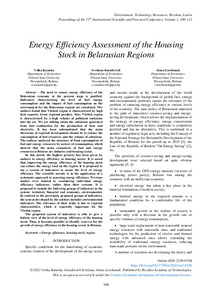Please use this identifier to cite or link to this item:
https://elib.psu.by/handle/123456789/28496Full metadata record
| DC Field | Value | Language |
|---|---|---|
| dc.contributor.author | Kameka, V. | - |
| dc.contributor.author | Izmailovich, S. | - |
| dc.contributor.author | Lisichonak, A. | - |
| dc.date.accessioned | 2022-01-04T05:58:09Z | - |
| dc.date.available | 2022-01-04T05:58:09Z | - |
| dc.date.issued | 2021 | - |
| dc.identifier.citation | Kameka, V., Izmailovich, S., Lisichonak, A. Energy efficiency assessment of the housing stock in Belarusian regions (2021) Vide. Tehnologija. Resursi - Environment, Technology, Resources, 1, pp. 108-112. | ru_RU |
| dc.identifier.uri | https://elib.psu.by/handle/123456789/28496 | - |
| dc.description.abstract | The need to ensure energy efficiency of the Belarusian economy at the present stage is justified. Indicators characterizing the level of fuel energy consumption and the impact of fuel consumption on the environment for the Belarusian regions are calculated. The authors found that Vitebsk region is characterized by high heat capacity Gross regional product. Also, Vitebsk region is characterized by a high volume of pollutant emissions into the air. We are talking about the emissions generated from fuel combustion for the production of heat and electricity. It has been substantiated that the main directions of regional development should be to reduce the consumption of fuel resources and the volume of emissions. The authors analyzed the structure of final consumption of fuel and energy resources by sectors of consumption, which showed that the main consumers of fuel and energy resources in Belarus are industry and housing sector. In this article the highest priority has been given by authors to energy efficiency in housing sector. It is noted that improving the energy efficiency of the housing stock can reduce the energy load on the region. It is proposed to use a system of indicators to assess the level of energy efficiency. The scientific novelty is in the application of a systematic approach to assessing energy efficiency. Previous studies were limited to considering individual energy efficiency indicators, rather than their systems. It is proposed to include the following groups of indicators in the system: technical, financial and economic, environmental. In contrast to the previously proposed groups of indicators, the system developed by the authors includes environmental indicators. The relevance of their study is due to regional characteristics, which is especially important for the Vitebsk region. The proposed system of indicators is able to give a holistic view of the level of energy efficiency of the housing stock. Thus, it becomes possible to identify reserves for the growth of energy efficiency in the housing sector in Belarus. | ru_RU |
| dc.language.iso | en | ru_RU |
| dc.publisher | Rēzeknes Tehnoloģiju akadēmija | - |
| dc.subject | Energy efficiency | ru_RU |
| dc.subject | Housing stock | ru_RU |
| dc.subject | Region | ru_RU |
| dc.title | Energy efficiency assessment of the housing stock in Belarusian regions | ru_RU |
| dc.type | Article | ru_RU |
| dc.identifier.doi | 10.17770/etr2021vol1.6520 | - |
| Appears in Collections: | Публикации в Scopus и Web of Science | |
Files in This Item:
| File | Description | Size | Format | |
|---|---|---|---|---|
| Kameka_Izmailovich_Lisichonak_2021.pdf | 110.18 kB | Adobe PDF |  View/Open |
Items in DSpace are protected by copyright, with all rights reserved, unless otherwise indicated.